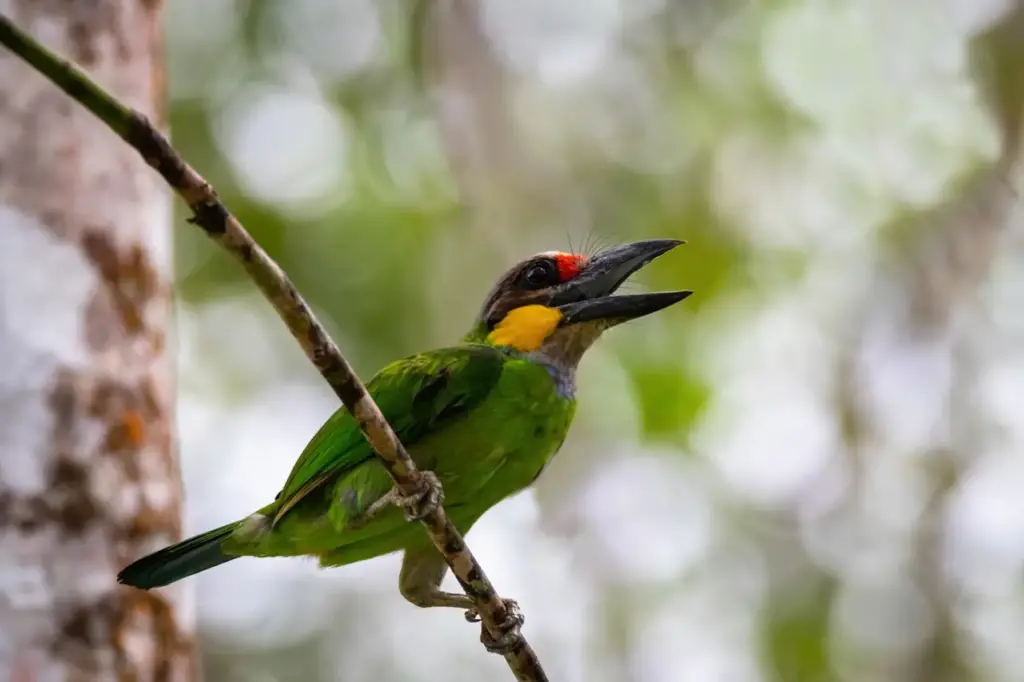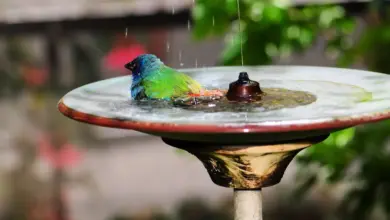The Golden-whiskered Barbets (Megalaima chrysopogon), a near passerine bird from Southeast Asia, is a species of Asian Barbet.
Like those species referred to by the common name “toucan”, the Golden-whiskered Barbet is in the Ramphastidae family.

Subspecies
The following three subspecies of Golden-whiskered Barbet have been identified:
- Megalaima chrysopogon chrysopogon
- Megalaima chrysopogon laeta
- Megalaima chrysopogon Chrysopsis
Description
At 24 to 30 centimeters in length and weighing from 110 to 181 grams, the Golden-whiskered Barbet is one of the largest of the sixteen species of barbets in Southeast Asia.
Their green overall plumage and yellow “whiskered” cheeks camouflage them amid the foliage they favor. Genders are similar in appearance but do display a small degree of sexual dichromatism in that the beaks of female specimens appear paler and have a dusky bluish color.
Before reaching maturity birds of both sexes have duller overall plumage.
Range
The Golden-whiskered Barbet is found in Brunei, Indonesia, Malaysia, Thailand, Borneo and Sumatra.
Habitat
They inhabit subtropical or tropical moist lowland forests and moist montanes. They are found in lowland foothills and tall second-growth forests but are rare in evergreen forests and swamp forests. The Golden-whiskered Barbet can also found be found on cocoa plantations.
Habit and Diet
This bird spends most of the day singing and foraging for food in the forest canopy. Otherwise well camouflaged, their rapid and extraordinarily loud “tehoop-tehoop-tehoop-tehoop” call often betrays their presence.
Golden-whiskered Barbets are frugivores that gorge themselves on berries, figs, and any edible fruits they can find. A bird watcher colorfully described the Golden-whiskered Barbet eating papayas in a private fruit orchard by writing:
What a glutton he was to possessively grab a chunk of the succulent fruit with his left claw; clung to the tree trunk with his right-footed zygodactylous toes and demolish another chunk of fleshy papaya breakfast in his honky beak…too engrossed in protecting his treasure trove of ripe and succulent papayas –spoilt for choice to take much notice of me…
Having had his fill, the barbet did not fly away but stayed around the tree to engage in sentry duties under the shade of a spoke-like foliage…Occasionally, he would return for a symbolic peck and indulgence of the fruits.
At other times, would fly to his shady, staging area for a quick snooze as expressed by his nictitating membrane, at the same time trying hard to possessively stay awake to watch his fruits…(he was also) seen to hastily chase off his mate. No other fruit-eating species of smaller birds present around dared or were allowed to perch on the same tree.
According to the same report, the Golden-whiskered Barbet is selective in its choice of fruits upon which to feed and does not bother to peck on intact ripening fruits when there are better fresh choices to be had.
Also partially insectivorous, the Golden-whiskered Barbet eats flying termites and has been observed digging into dead wood searching for food. It also feeds on seeds and even lizards and small birds like the Eurasian Tree Sparrow.
Reproduction
Breeding season for the Golden-whiskered Barbet is from February to August. Their rounded, white eggs are laid two per clutch.
Other names
In Mandarin Chinese, it is known as 金须拟䴕 (jīnxū nǐliè) “golden-whiskered false woodpecker” or 金颊拟啄木鸟 (jīn jiá nǐ-zhuómù-niǎo) or as “gold-cheeked false woodpecker”. Its Japanese name is キホオゴシキドリ or 黄頬五色鳥 (kihō goshikidori), “yellow-cheeked five-colored bird.” Bucco chrysopogon is a pseudonym.

